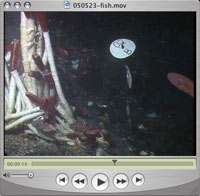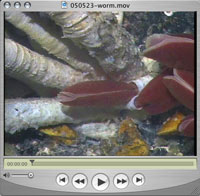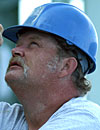|
|

 Today's Weather Blue Sky, Detached Clouds Lat: 0° 48.34’N Long: 86° 13.59’W Wind: SSE Sea State: 3 Swell Height: 4-6 feet Baro Prss: 1012.4 MB Air Temp: 24.3°C 75.8°F Sea Temp: 25.7°C 78.3°F  Quicktime Movie » Windows Media Player » These purple fish are called Bythites hollisi. They live only at hydrothermal vents on the East Pacific Rise and the Galapagos Rift. They are fast swimmers, so they are hard to catch with a special “slurp” machine mounted on Alvin.  Quicktime Movie » Windows Media Player » Red-tipped worms emerge from their white tubes. The shimmering water is due to warm, clear fluid flowing from cracks in the seafloor. 
Photographing the Seafloor Since deep-sea photography became possible in the 1950s, scientists have seen many new things, from black smoker chimneys, seamounts, and even the animals we are now studying at Rosebud. Cameras help scientists explore the deep, and plan dives to uncharted areas. A regular camera would not work in such an extreme environment, where it must take pictures in total blackness, crushing pressure, and freezing temperatures. On this expedition, several scientists have started using a specially designed digital camera system that is towed behind the ship as it photographs the seafloor. We call it the TowCam. The camera is towed 100 to 300 meters (328 to 984 feet) behind the ship at speeds of 1/4 to 1/2 knot, the equivalent of walking at a leisurely pace. After lowering the TowCam over the side of the ship, geologist Dan Fornari and volcanologist Adam Soule monitor its progress from inside the ship’s lab. They “fly” the TowCam about 5 meters (16 feet) above the seafloor. They track its depth and altitude, as well as water temperature, and water clarity, or turbidity. This information comes through a cable that links the TowCam to the ship. It also allows scientists to raise and lower the camera if they encounter deeper valleys or large rocks on the seafloor. Flying the TowCam requires concentration, as the system weighs nearly 1,300 pounds (585 kilograms) in water. It is approximately the size and shape of a refrigerator tipped on its side. “You do not want it to crash on the bottom,” Dan said. Power for the TowCam instruments and light strobes mounted to the system comes from four deep-sea batteries. Similar batteries are used to power motorcycles. But on the TowCam, they are immersed in oil to avoid being crushed under pressure at depth. The TowCam can take about 1,800 high-resolution, color photographs each time it is deployed. A new digital photo is snapped every 10 to 15 seconds. Each tow lasts 5 to 7 hours, and takes place at night after Alvin has returned to the ship. Like any digital camera, there’s no need to wait for printing. The TowCam stores all the images on a computer card in the camera housing. When the TowCam is back on the ship, the images are downloaded to a computer. “That’s the best part about the TowCam,” Dan said. “Within 45 minutes, scientists are looking at pictures of the seafloor.”
Interview  Bosun Wayne Bailey: Wayne is in charge of all deck activities on R/V Atlantis. He oversees the movement of heavy equipment on the deck, and uses a variety of hand signals—a closed fist means stop—to communicate clearly when crewmembers using the crane can’t hear his voice. Wayne started sailing on the Great Lakes, but has spent most of his 53 years on the ocean. Read the interview » Bosun Wayne Bailey: Wayne is in charge of all deck activities on R/V Atlantis. He oversees the movement of heavy equipment on the deck, and uses a variety of hand signals—a closed fist means stop—to communicate clearly when crewmembers using the crane can’t hear his voice. Wayne started sailing on the Great Lakes, but has spent most of his 53 years on the ocean. Read the interview »
Mail Buoy Do you have questions about oceanographic research, hydrothermal vents, or about what it is like to work on board a ship? E-mail your questions to the scientists working on board RV Atlantis at divediscover@atlantis.whoi.edu. Please tell us your town and state, and keep your messages short with no attachments. Read today's mail »
|
|||||||||||||||||||||||||||||||||||||||||||||||||||||||||||||||||||||||||||||||||||||||||||||
Mailing List | Feedback | Glossary | For Teachers | About Us | Contact
© 2010 Dive and Discover™. Dive and Discover™ is a registered trademark of
Woods
Hole Oceanographic Institution
